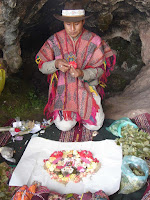 |
| The World Tree |
In world mythology, The World Tree is the axis mundi, world
axis, or central axis of the cosmos. Images of the World Tree exist in nearly
all cultures and represent the world center and/or the connection between
heaven and earth. The axis mundi links heaven and earth as well as providing a
path between the two. Many ancient cultures incorporate the myth of the World
Tree, Tree of Life, or Tree of Knowledge, as it is also known. The Mongols call this axis the turge tree. The mythic Eagle, who was
the first shaman (buu), perches at
the top of the turge tree, which
touches the sky by the Pole Star (Altan
Hadaas). A tree of seven branches with a bird or eagle at the top and a
serpent at the roots is symbolism often found on prehistoric monuments.
This central axis exists within each of us. Through the
sound of the drum, which is invariably made of wood from the World Tree, the
shaman is transported to the axis within and conveyed from plane to plane. As
Tuvan musicologist Valentina Suzukei explains: "There is a bridge on these
sound waves so you can go from one world to another. In the sound world, a
tunnel opens through which we can pass, or the shaman's spirits come to us. When
you stop playing the drum, the bridge disappears." The inner axis passes
through an opening or hole through which the shaman can ascend to the Celestial
Realm of unmanifest potential and descend on healing journeys into the temporal
realm of manifest form.
Read more.




















